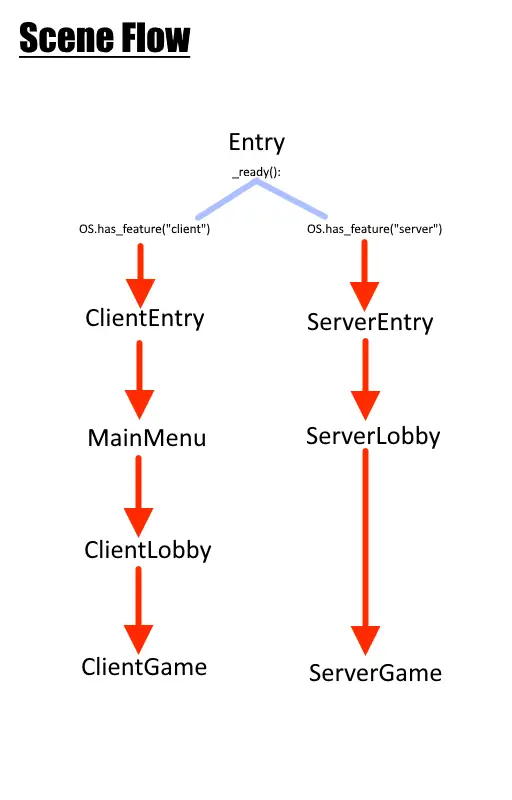Install Asset
Install via Godot
To maintain one source of truth, Godot Asset Library is just a mirror of the old asset library so you can download directly on Godot via the integrated asset library browser

Quick Information

A multiplayer project template allowing you to share all the code between the client and server, and export both from the same Godot project.Further, because the game logic is running on both client and server, you could have the server be authoritative if you design your game that way.Using the Linux dedicated server export template, you can run the server export on a headless machine.
GodotClientServer
A project template for a Dedicated Server & Client within a single project.
Why?
There is already a good tutorial out there showing how to set up a dedicated server in Godot using two separate projects. This has a number of advantages. However, it has in my view one huge disadvantage: Maintainability.
In a two project setup, you have to somehow keep shared logic in sync between the two projects. You can imagine a number of ways to do this, but I would massively prefer to just fix a bug once, and not have any steps to remember. Because I'll forget.
So this idea here is to have one Godot project, and keep as much of the code shared between client and server as possible.
High level design
This relies on an aspect of Godot's export system called "Features." Each export template specifies which Features it supports, such as Windows, 64 bit, PC vs Mobile, etc.
These are the built-in features, but Godot also allows you to specify your own custom features. So you could, for instance, have two different Windows Export Presets, and they could each contain different custom Features that you specify.
Importantly, the presence of these features can be queried at runtime:
OS.has_feature("X")
You probably see where this is going now.
We can have two different export templates, and each has it's own custom feature: client for one, and server for the other.
Our Main Scene will be a simple Entry scene that detects which feature is present, and then launches into a different Scene accordingly.
The Client will launch into a Main Menu, and the Server will launch into a Lobby scene, where it will open a port and begin listening for clients.
Project Structure
root/
|
- common
- client
- server
common contains the bulk of the game code. This is all of the code that runs on both client and server. This is where the real benefit of this architecture comes from.
Client/Server specific code
Each scene in common will have a corresponding inherited scene in both client and server. This allows you to do client or server specific stuff quite easily.
The scenes are named to prevent confusion in an editor so:
common/Lobby.tscn
client/ClientLobby.tscn
server/ServerLobby.tscn
So the only trick here is that scene transitions must be in the inherited scenes, since the server will change to ServerGame.tscn and clients will change to ClientGame.tscn. This can be accomplished easily with overriden methods or signals.
Running on a headless machine
If this was for some real game, the server likely would be on a headless machine. To accommodate this, we can use Godot's server export template. It is a graphicless version of Godot, and will not attempt to open a window or use any graphics API.
This means you can easily run the dedicated server on a headless Linux box.
https://godotengine.org/download/server
Exporting the Linux Server
In the Export Project dialog, click on the Linux Server preset. Then export the pack file, not the full Export Template.
You can then run the dedicated server as such:
./Godot_v3.2-stable_linux_server.64 --main-pack Server.pck
Down sides
- This will still load all of the graphical assets, so it will not be as slim in memory as it could possibly be in the two project approach.
Misc
- This is shown working with a Lobby based game, but it could just as easily work with a join-in-progress type of game.
- I'm not completely happy with how I split up the Network classes (BaseNetwork, ClientNetwork, ServerNetwork). So I may actualy get rid of that.
- This is NOT Server authoratative. It could be in theory, and that is one big advantage I see is that all of the game logic is already running on the server.
A multiplayer project template allowing you to share all the code between the client and server, and export both from the same Godot project.
Further, because the game logic is running on both client and server, you could have the server be authoritative if you design your game that way.
Using the Linux dedicated server export template, you can run the server export on a headless machine.
Reviews
Quick Information

A multiplayer project template allowing you to share all the code between the client and server, and export both from the same Godot project.Further, because the game logic is running on both client and server, you could have the server be authoritative if you design your game that way.Using the Linux dedicated server export template, you can run the server export on a headless machine.

